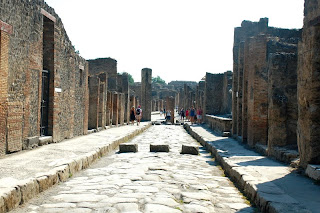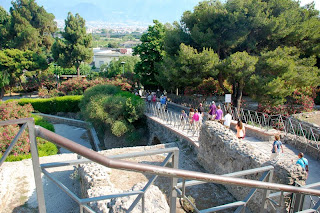After an Amazing morning in Capri and Sorrento, it was hard to fathom that we had yet another landmark location to tour!
The drive there along the Amalfi Coast was just Gorgeous!
We could see our destination from a distance...
As we pull in to our last, but not least, excursion site...
We began with a demonstration of how Cameo's are made...it was the least interesting thing we had down all day.
I am embarrassed to admit that I knew very little about Pompeii before researching it before our trip.
Needless to say, it's history is FASCINATING!
I pray that my pictures help bring it alive for you!
The city of Pompeii is a partially buried Roman town-city near modern Naples in the Italian region of Campania, in the territory of the comune of Pompei. Along with Herculaneum, Pompeii was destroyed and completely buried during a long catastrophic eruption of the volcano Mount Vesuvius spanning two days in the year AD 79. The eruption buried Pompeii under 4 to 6 meters of ash and pumice, and it was lost for nearly 1700 years before its accidental rediscovery in 1749.
Since then, its excavation has provided an extraordinarily detailed insight into the life of a city at the height of the Roman Empire. Today, this UNESCO World Heritage Site is one of the most popular tourist attractions of Italy, with approximately 2,500,000 visitors every year!
The town was founded around the 7th-6th century BC by the Osci or Oscans, a people of central Italy, on what was an important crossroad between Cumae, Nola andStabiae. It had already been used as a safe port by Greek and Phoenician sailors. According to Strabo, Pompeii was also captured by the Etruscans, and in fact recent excavations have shown the presence of Etruscan inscriptions and a 6th century BC necropolis. Pompeii was captured for the first time by the Greek colony of Cumae, allied with Syracuse, between 525 and 474 BC. Worth noting are an amphitheatre, a palaestra with a central natatorium or swimming pool, and an aqueduct that provided water for more than 25 street fountains, at least four public baths, and a large number of private houses (domūs) and businesses Although the blunts of the Social League, headed by Lucius Cluentius, helped in resisting the Romans, in 80 BC Pompeii was forced to surrender after the conquest of Nola, culminating in many of Sulla's veterans being given land and property, while many of those who went against Rome were ousted from their homes. It became a Roman colony with the name ofColonia Cornelia Veneria Pompeianorum. The town became an important passage for goods that arrived by sea and had to be sent toward Rome or Southern Italyalong the nearby Appian Way. Agriculture, water and wine production were also important. Graffiti - fish above, goat below
Time to explore the streets of Pompeii...
George & Greg in front of someone's abode
"Mama", our fabulous tour guide had a degree in archeology - thus, she was a WEALTH of information for us! She passionately educated on all things Pompeii.
At the time of the eruption, the town could have had some 20,000 inhabitants, and was located in an area in which Romans had their holiday villas.
Windows
Art
shocked to see such intricate design on exterior
Very decorative interiors
I was shocked to see that 700 bc civilization was so into Home Decorating!!
They even seemed to have color schemes
bird on left...decorative art on right
2 Story Home
Water basin
Walls
Large Home in Pompeii
Huge wall size mural
Dog Mosaic
By the look on his face, I'm guessing he was a guard dog?!
Apparently, Pompeii was the Las Vegas of the ancient world. It was a popular Roman vacation spot — the stomping grounds of the rich and famous.
As a result, the city is filled with mosaics, frescos, pottery, functioning kitchens, and all the other fine things of the day. About 20,000 inhabitants enjoyed a food market, a bar, many restaurants, several theaters, a gymnasium, aqueducts, baths, and even a hotel.
Red Light District
Address Plate
Fireplace
Even many recovered household items had a sexual theme.
Ancient Roman culture is very different from modern culture, but some things will never change. This penis, carved into a stone road at Pompei, points to brothel in the "Red Light" district of the ancient city. Some houses have special rooms set up for sexual encounters, with different sexual positions painted above the entryways to the rooms. It's astonishing to see how little--if at all--human sexuality has changed from ancient times.
In 1819, when King Francis I of Naples visited the Pompeii exhibition at the National Museum with his wife and daughter, he was so embarrassed by the erotic artwork that he decided to have it locked away in a secret cabinet, accessible only to "people of mature age and respected morals" Evidently due to its immorality, prior to or shortly after the destruction of Pompeii, one graffitist had scribbled "Sodom and Gomorrah" onto a wall near the city's central crossroads.[27] Many Christians have since invoked the destruction of Pompeii in warning of divine judgment against rampant immorality. Fountain
Mosaics were very popular in Pompeii - some were even on the floors!
In the midst of a day of immense education, A and I took a break to "Strike a Pose"!
The objects buried beneath Pompeii were remarkably well-preserved for almost two thousand years. The lack of air and moisture allowed for the objects to remain underground with little to no deterioration, which meant that, once excavated, the site had a wealth of sources and evidence for analysis, giving remarkable detail into the lives of the Pompeiians. Unfortunately, once exposed, Pompeii has been subject to both natural and man-made forces which have rapidly increased their rate of deterioration.
Wine jars have been found bearing what is apparently the world's earliest known marketing pun (technically ablend), Vesuvinum (combining Vesuvius and the Latin for wine, vinum) A recent multidisciplinary volcanological and bio-anthropological study of the eruption products and victims, merged with numerical simulations and experiments indicate that at Vesuvius and surrounding towns heat was the main cause of death of people, previously supposed to have died by ash suffocation. The results of this study show that exposure to at least 250 °C hot surges at a distance of 10 kilometres from the vent was sufficient to cause instant death, even if people were sheltered within buildings
Animals, as well as people, suffered on the day Vesuvius buried Pompeii. Left tied up by its master, this poor, abandoned dog was unable to flee from the destruction.
Giuseppe Fiorelli took charge of the excavations in 1860. During early excavations of the site, occasional voids in the ash layer had been found that contained human remains. It was Fiorelli who realized these were spaces left by the decomposed bodies and so devised the technique of injecting plaster into them to perfectly recreate the forms of Vesuvius's victims. What resulted were highly accurate and eerie forms of the doomed Pompeiani who failed to escape, in their last moment of life, with the expression of terror often quite clearly visible. There was also a pregnant woman, who lay belly down, covering her face. Her form, lonely and frightened, was a testament to human loss.
After thick layers of ash covered the two towns, they were abandoned and eventually their names and locations were forgotten. The first time any part of them was unearthed was in 1599, when the digging of an underground channel to divert the river Sarno ran into ancient walls covered with paintings and inscriptions.
Beautiful View
Time to make our way back to bus...
A few minutes left to shop before we departed...
lemons the size of canteloupes!
Time for our 1st Authentic Italian Pizza!
ummm...
He folded in in half and had it eaten in 30 seconds flat!
Homemade Pasta
And of course one last Gelato...
this time "Caffe" flavor - it was our Fave!!
The Staple Sighting of our Trip
Back to Naples
Napoli Port
Is this sign mean for Dumb Blondes, or what?! lol
Fast Foward 2 hours...
We were invited to a *Cocktail Party in the ING Exec's Suite
Feeling pretty Snazzy...other than of course I was down to a chambray sundress for attire options!
GASP!
From there we went to a 9:45 p.m. dinner reservation at , the high end Italian restaurant on the ship.
Portefino's
Talk about fancy, we were served our vino via a wine decanter and aerator...Ooh La La!!
We were there SO late, that I found myself putting a piece of decadent dessert in my mouth at 11:45 p.m.! NOT good for the diet. But, ooooh so good.
Here we go again!
Never a dull moment when you turn in for the evening...LOL!!!!
After days and days of working through the 1800+ pictures...tomorrow is the LAST POST.
yes, it's true :-)


















































































































